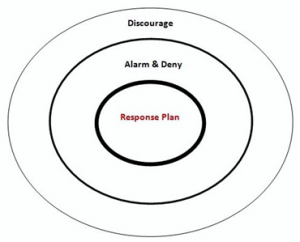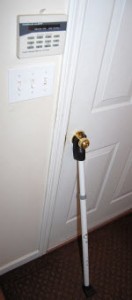When most people think about personal protection, they mainly think about how to stay safe outside their homes. While the vast majority of crime against citizens occurs outside the home, home invasion robberies and worse DO occur. Crime statistics are difficult to track down specific to “home invasion,” but “property-related crimes” (robbery or burglary) have steadily risen, with estimates placing these crimes at one property-related crime every three seconds. Between 1994 and 2005, there were more than 3,600,000 property-related crimes in the U.S. each year. One out of every five homes is just as likely to experience a robbery as they are to have a fire or carbon monoxide poisoning.
Unfortunately, many home invasions that begin as a simple robbery often turn into violent crimes such as rape and/or murder against anyone present in the home at that time. Like those of us on the right side of the law, criminals are educating themselves, using modern technology and getting better and better at their chosen professions. In the case of the 2007 Connecticut home invasion, torture, rapes and murders of the Petit family, serial criminals Joshua Komisarjevsky and Stephen Hayes were known for using night-vision goggles to aid in entering and navigating through homes.

Safe At Home Effective home safety preparation should consist of concentric rings of defense with a viable core response plan to any type of unauthorized home entry.Exterior lighting should be elevated out of reach and powerful.
Discourage
The outermost ring of defense preparation should discourage any potential criminals from selecting your residence. If a home appears to be prepared and like it may involve hard work or that the criminal may encounter resistance, most criminals will de-select and continue onto easier, less prepared targets.
Next, consider strong, elevated lighting on every side of the home, especially above or near key entry points. Use this lighting to eliminate any shadows created by the architecture of the home, again eliminating any potential hiding places in which criminals can lie in wait until they choose to take action. Small alarm system signs placed in windows and yards, the presence of a dog, and watchful neighbors may also discourage selection.
Alarm and Deny
The second ring of defense preparation is the Alarm and Deny phase. Similar to personal protection outside the home, awareness of potential trouble or criminal activity is vital to avoiding, escaping, diffusing or taking action to effectively defend oneself or others. The home is no different: the sooner we can locate and identify the threat, the sooner we can respond effectively.
Methods to effectively deny someone entry into a home is a broad subject requiring a dedicated article. The idea of denying entry focuses on slowing down entry into the structure in order to provide time to 1) escape and 2) initiate a response plan. For this article, some easy and effective measures for consideration include installing good locks and dead bolts at entry points with at least three-inch screws on heavy-duty strike plates in door frames. Next, consider buying some type of door brace. Door braces, such as the model pictured, which is manufactured by Mace, are cheap, easy to install and uninstall, and highly effective at slowing down entry into a space.
Response Plans
If entry into the home does occur, two scenarios need to be considered: 1) home invasion when the family is separated, and 2) home invasion when the family is or can be gathered easily and rapidly.
1) Separated: possibly the worst scenario, this situation relies heavily upon awareness of potential intrusion; identification of unauthorized access; and immediate, aggressive response. Focus is on securing separated family members and rejoining already secure family members in one defensible area or room while calling 911 and preparing to defend the secure area. Family members must know and understand their roles in the eventuality of this scenario, and the primary responder MUST have the skill sets to mount an aggressive and immediate response with or without personal defense tools. This scenario is grim, since space must be traversed rapidly in an effort to get to the separated family members as soon as possible. “Pieing” corners and tactical movement are secondary concerns when faced with the screams of a child, wife or other loved one.
2) Gathered: in this scenario, the primary responder should assemble family members in one secure area or room, contact 911, prepare to wait for help, and defend the secure area with whatever tools are available. Again, family members must have designated roles, such as one person immediately calling 911 while another secures a home defense weapon and gathers children or other family members.
Conclusion
This article is by no means all-inclusive of the countermeasures available for effective home defense. It is intended as a general outline that will hopefully provide the reader with some things to consider. Mounting an effective home defense and being safe at home do not have to cost a lot, but they do require pre-planning and a pro-active mindset. Don’t become a statistic — don’t be the one in five.


We have a complete castle law here in Italy. if you enter the house without permission we have a right to positive response. However you cannot respond if the intruder is moving away, ie in the back. What are the regulations like in the U:S:
Good article. With it only being two of us in the house it's easy to protect and defend our space. I even put 3 inch screws on our bedroom door so if someone does come into our home we have planed to lock the door, call 911 and wait. If the door handle jiggles or someone tries to gain entry thru the door they will be on the business end of my shotgun.
Brilliant! Thank you!
Good Info. I have a question though. I have a retired bomb/attack dog that is very protective of my family and property. If someone broke in the dog would attack!! In this case I would have to gain control of him prior to the police entering the house. I do keep a gun close. What would my best coarse of action be in this sinario.
that was very eye opening thank you.
Very intersting and helpful!!
Great article.
Great Info!
Nice Job. gets people thinking - this is going out to my son in law who was a victim of carbon monoxide poisoning. In other words "what are the chances of being victimized at home"! (The family survived and spent some time in the hyperberic chamber to force out the gas from their blood)
Great info, thanks!